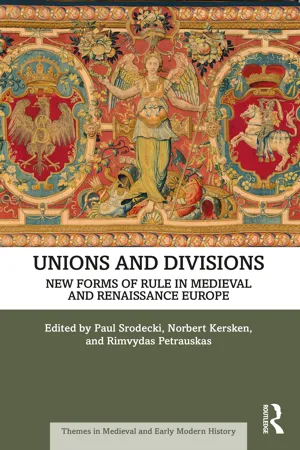
Unions and Divisions
New Forms of Rule in Medieval and Renaissance Europe
- 366 pages
- English
- ePUB (mobile friendly)
- Available on iOS & Android
Unions and Divisions
New Forms of Rule in Medieval and Renaissance Europe
About This Book
Providing a comprehensive and engaging account of personal unions, composite monarchies and multiple rule in premodern Europe: Unions and Divisions. New Forms of Rule in Medieval and Renaissance Europe uses a comparative approach to examine the phenomena of the medieval and renaissance unions in a pan-European overview.
In the later Middle Ages, genealogical coincidences led to caesuras in various dynastic successions. Solutions to these were found, above all, in new constellations which saw one political entity becoming co-managed by the ruler of another in the form of a personal union. In the premodern period, such solutions were characterised by two factors in particular: on the one hand, the entry of two countries into a union did not constitute a military annexation — even though claims to the throne were all too often imposed by force; on the other hand, the new unitarian constellation retained, at least de jure, the independence of its respective components. The twenty-four essays, ranging in scope from Scandinavia to Iberia, from England and France to Central and Eastern Europe, examine whether the respective unions were the result of careful planning and deliberations in the face of a long-foreseen succession crisis or whether they emerged from dynamic developments that were largely reactive and dependent upon various random factors and circumstances. Each union is assessed to provide an understanding, for students and researchers, of the political and social forces involved in the respective countries and investigates how the unions were reflected in contemporary literature (pamphlets, memoranda, chronicles, diaries etc.), propaganda and in legal and historical discourses.
This volume is essential reading for students and researchers interested in the history of monarchy, political history and social and cultural histories in premodern Europe.
Frequently asked questions
Table of contents
- Cover
- Half Title
- Series Page
- Title Page
- Copyright Page
- Contents
- List of Figures
- List of Maps
- List of Contributors
- Preface and Acknowledgements
- A Note on Names
- Abbreviations
- Part I: Conceptual and Theoretical Frameworks
- Part II: Between Coercion and Raison d'État
- Part III: Between Aspiration and Reality
- Part IV: Between Coincidence and Intention
- Part V: Between Dynastic Extension and Overstretching
- Index